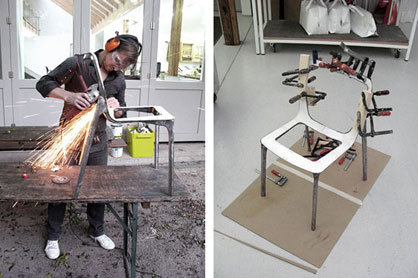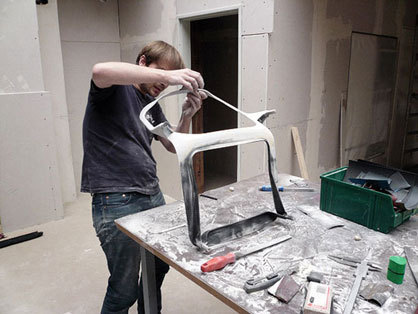Chassis
Text by Nora Schmidt
Berlin, Germany
30.10.08
Stefan Diez couldn't have conceived a more appropriate name for the multi-purpose chair which he has, over a development period of three years, designed for Wilkhahn, the German producer of office furniture.
«Chassis» – Stefan Diez couldn't have conceived a more appropriate name for the multi-purpose chair which he has, over a development period of three years, designed for Wilkhahn, the German producer of office furniture. In a restrained but definite way the chair reveals its technological origins – the automobile industry. «Chassis» is fast, dynamic and in spite of this robust.
Contrary to expectations its frame is not produced from the aluminium die casting which is standard in the furniture industry, but is instead deep-drawn from sheet steel in car body production. The shaped steel is not just highly flexible but its material thickness of just over one millimetre explains the unexpected lightness of the frame of only 2600 grams, and an overall chair weight of around four kilos.
The legs are made of tubing, with the lower section lightly milled and the upper section connected to the base of the seat by hydroforming – a process in which the shape of the metal tubing is modified from the inside by water pressure. The rear legs are connected at an angle to the frame at the level of the backrest, which enables better distribution of pressure and provides the chair with additional dynamism and flexibility. The leather which is used for the seat is fitted to the frame and its shape is, in line with the overall concept, modified as little as possible. A welcome side effect is that the chair consists of only two materials and that these can be fully recycled.
Munich's Stefan Diez and his team have managed to combine traditional craftsmanship with innovative manufacturing techniques without giving the product a high-tech look. Like most of the objects designed by Stefan Diez the Wilkhahn chair impresses with its matter-of-fact simplicity. Every detail appears perfectly logical – the word 'luxury' is not the right one for this pure formal coherence, because Chassis is much more than this.
Chassis is at present still in the prototype phase. However, at Wilkhahn it has already been decided that Chassis should go into series production as quickly as possible. After the highly positive response at this year's Orgatec, the risk involved in the expensive production of the necessary tooling has been reduced. The first series model of Chassis will probably roll off the production lines in 2010.







